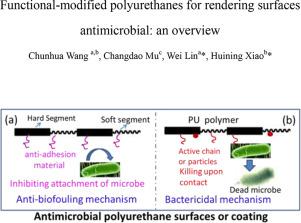Advances in Colloid and Interface Science ( IF 15.9 ) Pub Date : 2020-08-11 , DOI: 10.1016/j.cis.2020.102235 Chunhua Wang 1 , Changdao Mu 2 , Wei Lin 3 , Huining Xiao 4

|
Antimicrobial surfaces and coatings are rapidly emerging as primary components in functional modification of materials and play an important role in addressing the problems associated with biofouling and microbial infection. Polyurethane (PU) consisting of alternating soft and hard segments has been one of the most important coating materials that have been widely applied in many fields due to its versatile properties. This review attempts to provide insight into the recent advances in antimicrobial polyurethane coatings or surfaces. According to different classes of antimicrobial components along with their antimicrobial mechanism, the synthesis pathways are presented systematically herein to afford polyurethane with antimicrobial properties. Also, the challenges and opportunities of antimicrobial PU coatings and surfaces are also discussed. This review will be beneficial to the exploitation and the further studies of antimicrobial polyurethane materials for a variety of applications.
中文翻译:

用于使表面具有抗菌性的功能改性聚氨酯:概述。
抗菌表面和涂层正在迅速成为材料功能改性的主要成分,并在解决与生物污染和微生物感染有关的问题中发挥重要作用。由软和硬链段交替组成的聚氨酯(PU)由于其通用性而成为最重要的涂料之一,已广泛应用于许多领域。这篇综述试图提供有关抗菌聚氨酯涂料或表面的最新进展的见解。根据不同种类的抗微生物组分及其抗微生物机理,本文系统地提出了合成途径,以提供具有抗微生物性能的聚氨酯。此外,还讨论了抗菌PU涂层和表面的挑战和机遇。







































 京公网安备 11010802027423号
京公网安备 11010802027423号